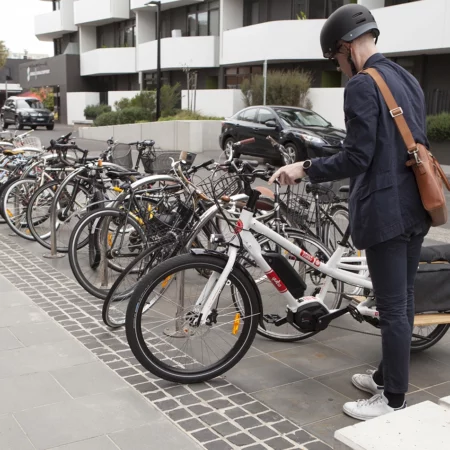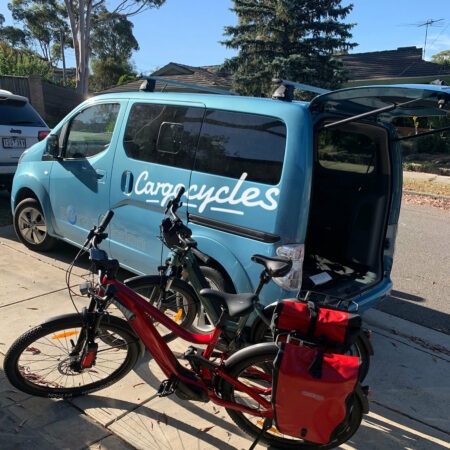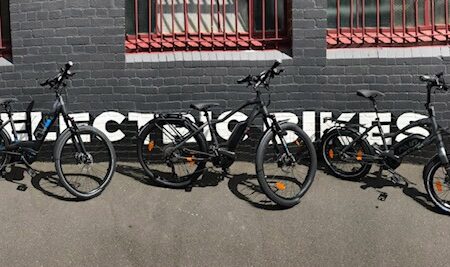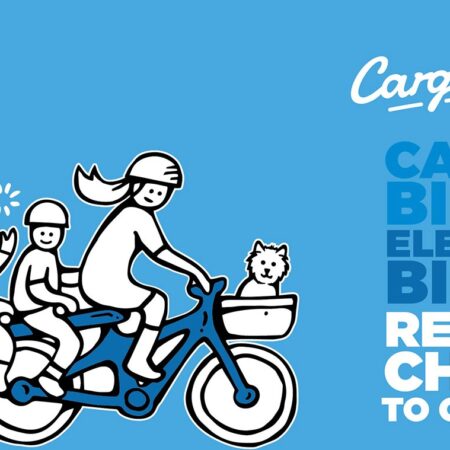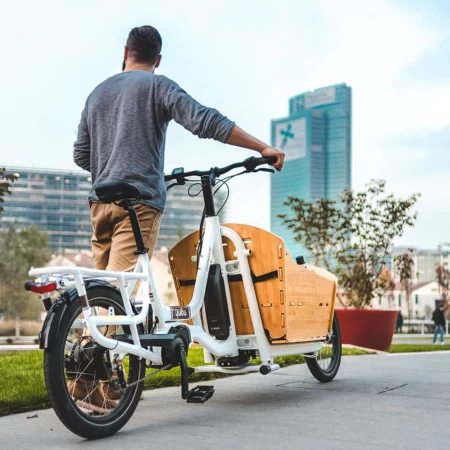As the age old adage goes … nothing lasts forever !
Like a lot of items, the design and manufacture of a bicycle and its components is a balancing act between being strong, light weight and cheap, and its widely quoted that you can only choose two of those things !
The main objective of a bicycle is to be efficient, and in order to be efficient one of the design goals is to make the components as light as possible, while also being able to last an acceptable period of time.
Starting with the frame, which is probably the biggest component of a bicycle, it can be manufactured from a variety of material, Steel, Aluminium, Carbon, Titanium … Bamboo ! You name it, and there is probably a bicycle out there somewhere made of it.
Each material has its own benefit(s) but all have a finite fatigue life (there is an argument that Carbon does not, but given the lack of Carbon cargo bikes which are our main discussion point … we will leave that as a moot point)
As metal frames are put to use, there is a small amount of flex. The design of the bicycle, and the material will determine just how much, and where the flex occurs.
A well designed bicycle will have enough strength to minimise the flex, while still allowing some movement to provide a degree of compliance in order to improve the ride feel of the bike, as well as lessening the impacts / stress through the frame.
During the manufacture process, extreme levels of stress can be put into the frame as the various tubes are bent, and joined through the application of heat. Some materials can become brittle through this process, while the elements of the frame can also pull against each other creating tension.
Again, a well manufactured frame will have additional processes to relieve / correct this.
All (legal) bicycles and their components have to be fatigue tested, and electric bicycles have a higher level of testing then “normal” bicycles that they are subject to.
Currently all (legal) e-bikes sold in Australia are tested to EN15194, which includes tens of thousands of repeated “flex’s” of the frame, in addition to various drop tests … including dropping heavy weights onto various areas of the frame and its components.
Example of a typical DIN testing report for a frame, N = Newtons of force while the “Cycles” refers to the number of times the test is performed. For reference a 10N is approx. 1kg of weight being applied.
One of the risks of non compliant e-bikes is they likely have not been tested appropriately, which when you are carrying vulnerable passengers is pretty scary. Given they are typically over powered as well it can be a recipe for disaster. Remember also, all components are subject to testing which insures things like wheels, tyres and more importantly braking are all up to the task !
The idea of the testing is to mimic the worse case scenario of the “durable life” of the bike in typical real world circumstances.
But … as per the opening line, nothing lasts forever, over time all those imperceptible flexes and movements will start to weaken the material, and the stress will typically centre on certain points (typically where frame tubes join)
Think of a paperclip being repeatedly bent, before to long the metal starts to fatigue, and starts losing strength before finally failing and snapping. On a microscopic level this is what can happen to bicycle frames.
Different materials have different failure characteristics, steel tends to be softer and therefore able to flex and bend slightly, but is likely to fatigue quicker and fail, while aluminium can be more “brittle” but arguably more durable, but more likely to crack / snap.
Back in the heady days of road racing, some typical frames were subject to exhaustive testing, the results can be found HERE which reinforces the characteristics of materials typically found on Cargo Bike frames.
Typically, we would expect a heavily used cargo frame to last between five and ten years depending on how well the bike is maintained, and any external influence such as impacts, rust etc.
Things like corrosion etc can hasten the demise of bike frames, as can impacts or mis-use. Regular cleaning and servicing of bikes will certainly help. Moisture trapped in a layer of dirt is never a good thing especially on steel frames. Aluminium can also suffer from Galvanic corrosion as well if the wrong parts are fitted, or fitted incorrectly and a conductive element (think salt water) is introduced into the mix.
A good indication of quality would be the manufacturers warranty. The longer the warranty then arguably the more confident they are in their processes and how long they expect the frame to last.
So that’s frames covered off, what about all the components attached to the frame ?
All the “bits” attached to the frame are considered consumable items, even the motor and the battery in the case of E-bikes!
Typical life spans of things like chains and cassettes on a heavy mid-drive cargo bike would be around 2500 Km’s, brakes vary a little bit depending on type, but they would be between 2500km’s and 5000km’s
Regular cleaning and lubeing of the chain can drastically extend its life.
Wheels, a well built wheel “shouldn’t” have issues with broken spokes.
Quality spokes are designed to flex, and the use of brass nipples are less likely to corrode and break. However it is very important if you ever do break a spoke to have it replaced immediately, as all the stress is taken up by the neighbouring spokes, which can quickly be overloaded and / or the rim itself being damaged.
The main thing to wear on wheels are the bearings in the hubs. These should be serviced every 2500km – 3000km’s to lengthen their lifespan.
Some designs have an “open” cup / cone setup, where loose ball bearings sit in a bath of grease, and tension is set with a series of locking nuts. By design then tend to be very cost effective, and also efficient, but do need a regular grease change to prevent wear.
Other hubs have “sealed” bearings, so less prone to the elements as they have additional seals to prevent water getting into the mix, trade off being slightly more resistance and availability of replacement bearings can vary.
Quality e-bike tyres should last around 5000’kms (outside of things like cuts / damage etc). Most important thing is keeping them adequately inflated.
Modern tyres are now rated for e-bike use, typically E-25 and E-50, with the numbers referring to the maximum rated speed. The other thing to ensure is the load rating of the tyres is sufficient for the GVM of the bike.
Rims on really heavy bikes can suffer, being part of a structural chain of the hub / spokes / rim they can over time fatigue and crack (certainly not common but we do occasionally see it). Regular tensioning of the spokes certainly helps, as does sufficient tyre pressure to prevent the rims striking against hard objects (potholes !)
We highly recommend at least annual services on Cargo bikes, it’s much better to replace a drivetrain component before there is a knock on affect to related (expensive) parts (think a worn chain writing off an expensive cassette !)
And what about all the Electrics …
Much like the opening paragraph relating to the bicycle frame, electric motors are built with some compromises in mind.
Weight is still important, but so is the resistance (or lack of) when you are pedalling. This means things like seals that stop water getting inside the motor need to be “loose” enough for the axle that passes through them to easily rotate.
There are also seals on all the various bearings inside the motor, and again they need to balance keeping moisture out, the grease in, and still be able to freely spin.
This leads to probably the biggest “killer” of e-bike motors … moisture !
Water inside the motor can be caused not only by the seals failing, but also the build up of condensation internally from the heating / cooling cycles. There’s a lot of electronics inside the motor and they don’t like to get wet!
Rust / corrosion can also form on the bearings, a lot of motors have what’s called a Sprag clutch … which is the engineering equivalent of a Chinese finger trap. It connects the motor to the cranks / pedals when “locked” and then allows the cranks / pedals to spin freely when “unlocked”.
We see these along with the main cranks bearings fail occasionally due to water ingress.
Typical life span of a good quality motor on a Cargo bike would be around 15’000 km’s. Again maintenance can improve things. Keeping seals greased, replacing bearings before other components are damaged etc can extend the lifespan.
We have seen motors still happily going at 30,000km’s +
The battery. Again this is considered a consumable part. With the vast vast majority of E-bike batteries relying on Lithium cells, they will degrade over time.
Much like a cell phone, when brand new they last for days … but after a few years you’re down to charging it every night.
As the battery cells degrade, the distance you can travel on a charge will be reduced. When fully degraded you may find the battery will also switch off when under heavier loads.
The one thing that can kill a battery though is over-discharge. This can occur when the battery is not charged for an extended period of time, exacerbated if it’s close to fully discharged when first left.
Majority of manufacturers require their batteries to be charged at least once every 3 months, even if not in use. Its better to regularly top up a batteries charge rather than fully discharge / recharge.
And lastly, electrical spikes or shorts when charging, we highly recommend using some form of circuit protection when charging to reduce the chances of power surges. Especially given it can be a fire source if damage does occur.
Always use the supplied charger, and we mean ALWAYS, keep everything away from moisture and fuel sources.
So there we have it, hopefully you can enjoy many, many years of happy riding on your Cargo bike if you give it a bit of love and attention occasionally.
We are always happy to have a quick look over your bike and let you know if anything needs some attention, plus show you what to look out for in the interim.
When the useful life of your bike or its components is over, continued use is hazardous.
Every bicycle and its component parts have a finite, limited useful life. The length of that life will vary with the construction and materials used in the frame and components; the maintenance and care the frame and components receive over their life; and the type and amount of use to which the frame and components are subjected. Use in competitive events, trick riding, ramp riding, jumping, aggressive riding, riding on severe terrain, riding in severe climates, riding with heavy loads, commercial activities and other types of non-standard use can dramatically shorten the life of the frame and components. Any one or a combination of these conditions may result in an unpredictable failure.
All aspects of use being identical, lightweight bicycles and their components will usually have a shorter life than heavier bicycles and their components. In selecting a lightweight bicycle or components you are making a tradeoff, favoring the higher performance that comes with lighter weight over longevity. So, If you choose lightweight, high performance equipment, be sure to have it inspected frequently.
You should have your bicycle and its components checked periodically by your dealer for indicators of stress and/or potential failure, including cracks, deformation, corrosion, paint peeling, dents, and any other indicators of potential problems, inappropriate use or abuse. These are important safety checks and very important to help prevent accidents, bodily injury to the rider and shortened product life.
Perspective
Today’s high-performance bicycles require frequent and careful inspection and service. In this Appendix we try to explain some underlying material science basics and how they relate to your bicycle. We discuss some of the trade-offs made in designing your bicycle and what you can expect from your bicycle; and we provide important, basic guidelines on how to maintain and inspect it. We cannot teach you everything you need to know to properly inspect and service your bicycle; and that is why we repeatedly urge you to take your bicycle to your dealer for professional care and attention.

